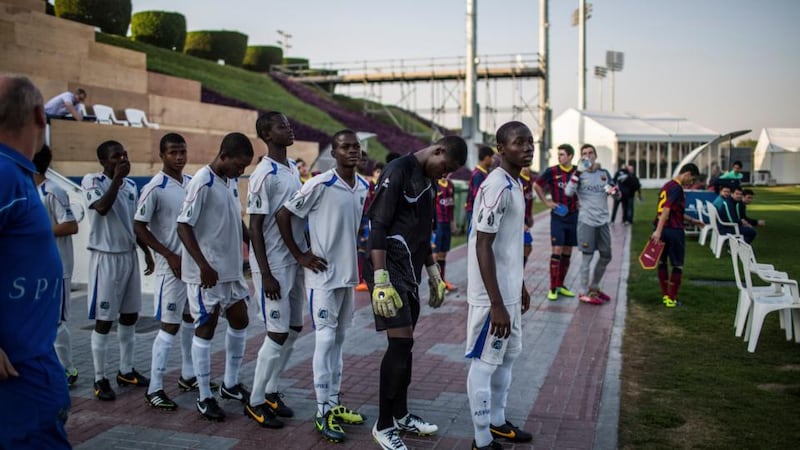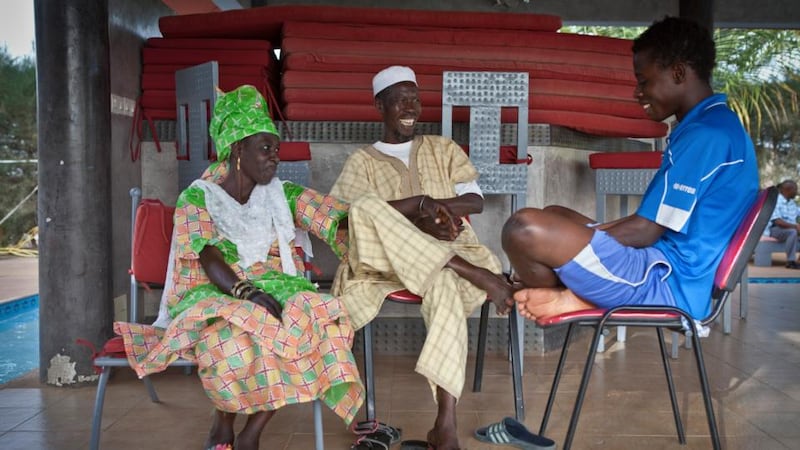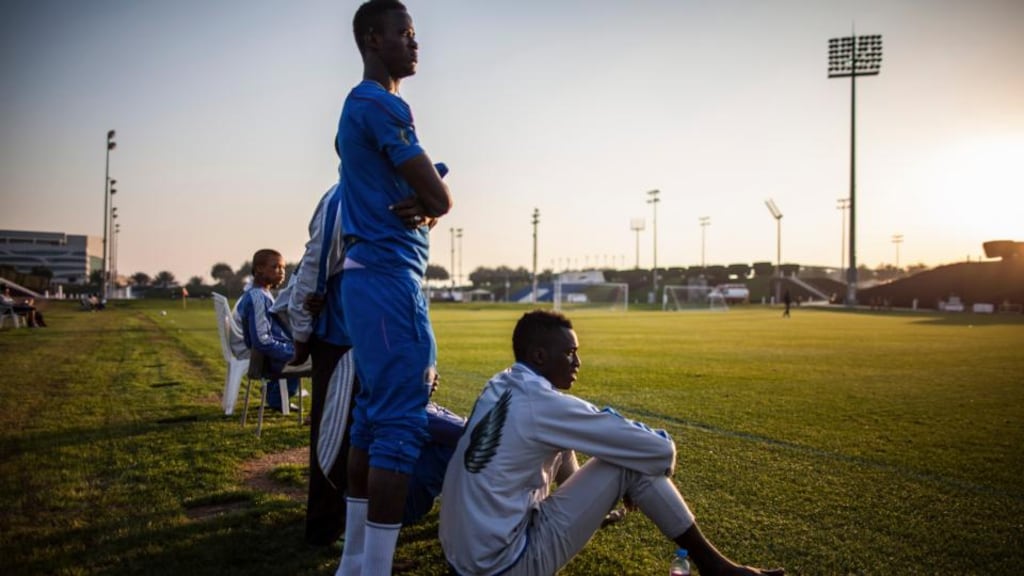A little more than a decade ago, Andreas Bleicher, then a director of one of Germany’s Olympic training centres, arrived in the tiny Persian Gulf nation of Qatar, wooed there by its royal family to help turn the hopeless football programme into something worthy of the world’s respect.
There were plenty of reasons this would be difficult – the country hardly has a tradition of football excellence, and its record of producing premier athletes in any sport is sparse. But there was one problem that seemed insurmountable. With a native population of only 300,000, Qatar simply did not have enough young players to form a team that could hope to compete with the likes of Brazil, Argentina and Germany.
"We were trying to build a national programme with a talent pool the size of one you might find in a small United States city," Bleicher said. One of his early hires was Josep Colomer, a former youth scout for FC Barcelona generally credited with discovering Lionel Messi, when Messi was a boy in Argentina. Colomer was known in for his unorthodox ideas, and soon he began talking about importing talent to Qatar from Africa, where even children in the most far-flung villages grow up playing the game.


"Many of the players there, they don't have any chance to be seen, to be discovered," Colomer said. The possibilities were tantalising. What if Qatar could send expert scouts throughout Africa on a mission to identify young, talented boys and offer them scholarships to come train at Qatar's Aspire Academy, the new, glimmering sports institute that was bankrolled by the royal family?
From that simple premise unspooled a wildly ambitious plan that reached from the dusty fields of Senegal and Kenya to the cloistered royal palaces of Qatar to a rundown stadium in a sleepy corner of rural Belgium. Let other countries start small. In the first year alone, Qatar screened nearly 430,000 boys in 595 locations across seven African countries. More than seven years later, Aspire has screened 3.5 million young athletes across three continents and cherry-picked the most promising boys for odysseys that have spanned the globe. Lower-level team The programme has taken Samuel Asamoah from Ghana to Qatar to Senegal to Belgium, where the royal family purchased a lower-level team as a strategic outpost to develop its players (far) away from the spotlight. It has taken Anthony Bassey from Uyo, Nigeria, on a similar journey.
The programme’s limitless scale is in keeping with Qatar’s broader desires to establish itself as a major player in all of its pursuits. The Qatari government – and, more important, the royal family – is determined to use the country’s immense natural gas and oil wealth to elevate its international standing overnight in the realms of architecture, commerce, culture, education, and sports. There is even a formal plan, Qatar National Vision 2030, which pledges that the country will become “an advanced society” within 16 years.
Those ambitions are on display across Doha: Six US universities are housed on a sprawling compound known as Education City; the IM Pei-designed art museum rivals the Jean Nouvel-designed history museum; and more construction is everywhere, much of it overseen by the Supreme Committee for Delivery & Legacy.
As for its football ambitions, Qatar has a deadline to deliver a team that looks as if it belongs on the world stage: the 2022 World Cup, which Qatar will host. When Qatar won its 2010 bid to host that tournament – a process tainted by accusations of rampant bribery – it earned the host's privilege of an automatic berth at the games. It will most likely be Qatar's debut in the World Cup. The Maroon, as the team is known, sits at 92nd place in the latest world rankings, between Iraq and Estonia.
When Qatar hosts the World Cup in eight years, its standards for success will be far different from the tournament that ended in Rio de Janeiro with Germany defeating Argentina, 1-0, in extra-time. Brazilian leaders were thrilled that the tournament had gone off without a major incident – no stadiums collapsed, no riots marred the games.
When the world’s attention turns to distant Qatar in 2022, the royal family wants to inspire nothing less than utter astonishment. Providing premier stadiums and unrivaled spectacle will be easy – that just costs money, of which Qatar has plenty.
Far more difficult will be fielding a credible national team. So what is a royal family with unlimited resources to do? Cue the African teenagers. Bleicher and Colomer insist they have sought out the best young African athletes as a way to provide high-level competition for Qatari boys, and not, they maintain, so that African players can line out en masse for Qatar’s national team. But there remains a possibility, albeit a remote one, that some African players could represent Qatar in 2022.
“Could it happen?” Bleicher said. “I suppose maybe some of the players feel like they would want to represent Qatar, because Qatar helped them when their home countries did not.”
But naturalisation rules make it difficult – requiring players to live in the country for five continuous years after they turn 18. Bleicher said he believes it is more likely that the African athletes end up representing their native countries, where their success would then reflect back on Qatar and its training programme. A number of the boys have already played for their home nations. “If we naturalise a few players, what will happen?” Bleicher said. “Everyone will kill us. Everyone will see. We are not stupid, and neither is anyone else.”
Critics, though, have long been sceptical of Aspire Football Dreams, the name of the international recruitment programme. Some believe Qatar will ultimately attempt to naturalise some of the boys. Others have suggested that the programme was designed to curry favor with the Fifa panel that awarded the 2022 tournament. And some fear that the boys, selected at 13 years of age, are being exploited.
Yet Qatar maintains there is a higher purpose, a humanitarian impulse to aid a largely beleaguered region even as it helps to rebrand the emirate, which has been criticised by human rights groups for abusive treatment of migrant labourers. Influential force For all its scope, Qatar’s international football machine was built largely on the word of one man: Sheik Jassim bin Hamad Al Thani, the brother of the emir and the most football-mad member of the royal family. At one time, it was assumed that Al Thani would be the next emir of Qatar, but in 2003, his younger brother succeeded him as crown prince and ascended as emir last year. Al Thani has remained a quiet, influential force, however, and has guided Qatar’s development.
In 2006, Bleicher and a group of Aspire executives met with Al Thani in his former office near the top of the 30-storey Qatar Olympic Committee Building. Others who have met with Al Thani say that there is sometimes a lengthy wait for an audience with his highness, as he and other royals are called (his actual name is rarely uttered). Once a meeting begins, however, Al Thani asks incisive questions and makes rapid-fire decisions.
“We did not need to convince him,” Bleicher said of the discussions with Al Thani about the Africa plan. “You don’t convince him.” He went on: “He was excited and delighted and this is why he gave his approval. If he did not like it, he would not give his approval.”
Anywhere else in the world, the Aspire programme would have sounded like a fever dream. But here it was but a small part of the larger, nearly incomprehensible fever dream that is on display in Doha everywhere you turn.
In April 2007, Aspire announced that it was embarking on an international talent search called Aspire Africa. The original plans called for scouts to be dispatched to seven African countries – Morocco, Cameroon, Ghana, Kenya, Nigeria, Senegal and South Africa.
In that first year, the trials were heavily publicised, on television and radio and on posters in small villages. The project was supported by Nike, as well as Bonus Sports Marketing, a consulting firm founded by Sandro Rosell (who later became the president of Barcelona).
From the start, the programme was marketed as a chance for young African boys to have a shot at a new life, one that could drastically change the possibilities for him and his family and even his community. “In the beginning, the people in Africa, they didn’t believe we were coming,” Bleicher recalled.
When the scouts arrived, driving through the villages in SUVs, they were often mobbed by young boys hoping to catch their attention. The trials sometimes took place on bare fields in remote and even dangerous places.
After watching local training matches for days, the scouts invited 50 players from each country for a weeklong trial in their home nations’ capitals. The three best boys from each country, along with the best three overall goalkeepers, were then taken to Aspire Academy in Doha for more trials.
For nearly all of the finalists, the trip to Qatar was their first time on an airplane. The Aspire dorms, which resemble upscale hotels, were baffling palaces where some boys needed help working the glass elevators. The crown jewel of the Aspire campus is its multipurpose dome, said to be the largest of its kind in the world, which includes a Fifa-regulation pitch, an Olympic-size swimming pool and a 1,200-seat amphitheatre. Across the campus, speakers pipe in the sounds of birds chirping throughout the day.
Aspire originally planned to offer scholarships to only three finalists, who would then come to Doha to live and train. But once the scouts saw the wealth of talent on display, they scaled up their ambitions, allowing for scholarships for up to two dozen boys, many of whom would live and train at a satellite academy opened in Senegal.
According to an internal concept document shown to the New York Times, Aspire executives initially saw the Senegal academy as a place to develop a potential “talent pool” for Qatari football clubs and to enhance Aspire’s “image as the world’s best talent pool”. “We realised that the level of the players was huge,” Colomer said. “And we could organise an academy with these players to give them a hope and a chance to grow to the high levels.” Tough transition In the years that followed, Aspire Africa was rebranded as Aspire Football Dreams, its scope expanding to as many as 17 countries, including three in the Americas (Guatemala, Costa Rica and Paraguay) and two in Asia (Vietnam and Thailand). By bringing the boys to the academies in Qatar and Senegal at such a young age, Aspire shouldered responsibility for their development not just as players, but as people. The transition has not always been easy.
“They come from the mud huts in Africa to this spaceship,” said one former Aspire coach, who wished to remain anonymous because he still works in the sport. There are language differences, and players get homesick.
Bleicher acknowledged that a scholarship away from home can be trying, but he said that Aspire offered its players more than most academies in terms of medical care, education and training. According to an agreement reviewed by the New York Times, a Football Dreams scholarship offered room and board and training and schooling, a few hundred euros per month in spending money, as well as tickets for the boys to travel home and for parents to visit. The families also receive as much as $5,000 per year, a sum that in many cases would be several times a family’s annual income.
At the start of 2014, there were about 70 boys living at the Senegal academy. Last year, Aspire brought Lionel Messi to its Senegal campus to announce plans to distribute 400,000 mosquito nets and place a medical official in every African town where Football Dreams operates. “I believe we can use football and the inspirational power of sport,” Messi said at the event, according to an Aspire news release, “to really make a difference.” Paying Foreign Athletes Despite Qatar’s insistence that Football Dreams was always intended as a humanitarian mission, the programme drew intense criticism almost as soon as Aspire’s scouts set off in search of African talent. The unease was due in part to Qatar’s recent history of paying to import foreign athletes to represent it in international competitions.
It happened in football as well. In 2004, three Brazilian players were poised to play for Qatar, but Fifa quickly announced new rules blocking naturalisations where there is not a clear connection to the new country. The British newspaper the Observer reported in November 2007 that some considered Aspire Africa to be “human trafficking” in the guise of humanitarianism, “with the sole intention of providing Qatar with footballers for their future national team.”
The article included a quote from the Fifa president, Sepp Blatter, who called the programme a kind of "exploitation." He later visited Qatar and, according to a news release issued by Aspire, changed his mind and lent his support to the programme. Naturalised imported players Yet some in Doha have apparently pondered the question of whether it is worthwhile to recruit foreign players to become Qatari citizens. One former Aspire executive said that, in private meetings, influential Qataris wanted to know why they should not be able to naturalise the imported players – Qatar had trained them after all – and in that way bolster the national team.
“For them, they pay for it,” the former executive said. “Other people have a big chance to have an easy life sponsored by the Qataris.” Bleicher acknowledged that at the beginning of the project, the question of “whether some participants could one day play for Qatar” was “raised, but dismissed.” “It did not align with the purpose of the project and the values of Aspire,” he said.
Even if, as Bleicher and others insist, the boys do not play for Qatar in 2022, some saw the international recruitment programme as a piece of Qatar’s multipronged effort to win the World Cup bid. In interviews, Qatari officials and Aspire executives denied this was the case, emphasising that Football Dreams was a costly programme meant to help needy nations and that it provided minimal benefits for Qatar.
“Honestly, the amount of times that we mentioned it were minimal,” Hassan Al-Thawadi, the chief executive of Qatar’s bid committee, said, referring to the notion that Football Dreams played a key role in the 2022 campaign. Documents reviewed by the New York Times suggested otherwise. During the summer of 2009, Aspire Academy’s marketing and communications department drew up a proposal that detailed precisely how Aspire Football Dreams could help Qatar’s bid for the World Cup.
A number of news stories have raised claims that Qatar, separate from Aspire, attempted to rig the bidding process with money. Qatar has denied the allegations, and Fifa is investigating. Of the 24 nations with delegates on the Fifa executive committee, five were countries in which Aspire Football Dreams was operating, the proposal explained. Some in Aspire thought this would bolster Qatar’s chances for the World Cup.
“Every country where projects are conducted should vote for Qatar,” the proposal read. “Five votes could be directly rendered favorable via an influence from Football Dreams.” Bleicher said Aspire’s marketing department, which created the proposal, had no bearing on the 2022 bid campaign.
“It shows the passion - but should not be mixed up with action, reality and responsibility,” he said. Qatar’s written bid has not been made public, but the New York Times reviewed a portion of it titled “Football Development,” which highlighted Qatar’s contribution to the growth of football at home and abroad. Aspire Football Dreams was mentioned several times, with discussion of its plans for further expansion in Thailand and Nigeria, both of which had votes on the executive committee.
It is unclear whether Aspire Football Dreams influenced the executive committee, which cast secret ballots. But in a shock to much of the football world, Qatar won the bid, well ahead of the United States, which finished second. Four years later, Qatar has not made a significant investment in either Thailand or Nigeria.
The Football Dreams teams have won several international contests. But with this success has come tension. Scouts coveted some of the Aspire boys for their own development clubs in Europe, and in 2011, several players split from Aspire to pursue opportunities elsewhere. Aspire executives were displeased by the departures.
And four years from now, the very best of them could be playing in the 2018 World Cup, to be held in Russia. Even if they are not wearing Qatar’s maroon jerseys, the players will bring Qatar the international respect the royal family has so far been unable to establish on its own soil. “The next World Cup,” Bleicher said, “will be ‘our’ World Cup.”
New York Times Service















